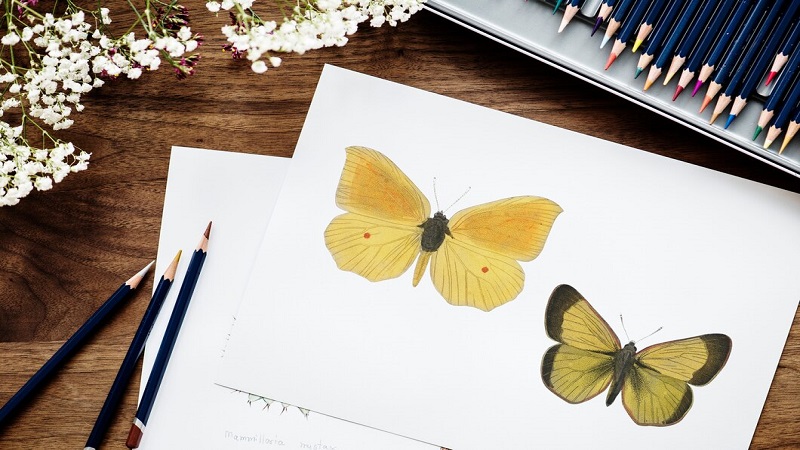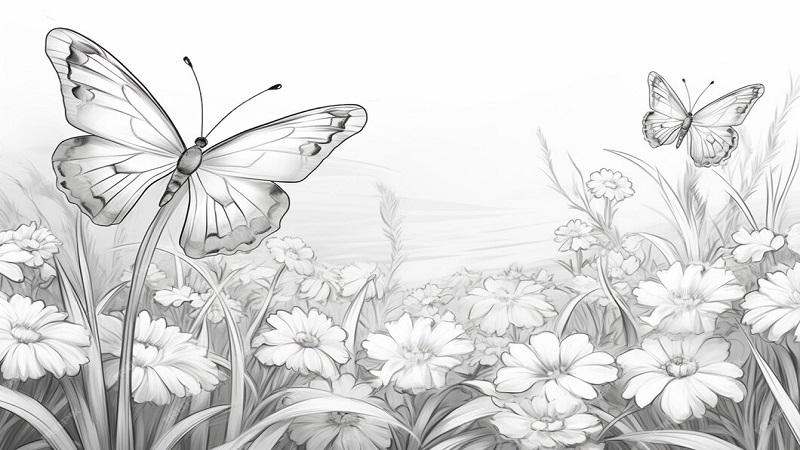Butterflies are among nature’s most beautiful creatures, symbolizing transformation, freedom, and grace. Drawing a butterfly allows you to capture this beauty on paper, making it a favorite subject for artists, both beginners and professionals. In this guide, we will walk you through the process of creating a sketch:q5pbirjjkfa= butterfly drawing, exploring different techniques, tools, and tips to perfect your artwork.
Why Draw Butterflies?
Butterflies are an excellent choice for sketching due to their symmetrical patterns and vibrant colors. They also present a fun challenge for those looking to improve their drawing skills. Whether you’re sketching for relaxation, learning, or artistic expression, the sketch:q5pbirjjkfa= butterfly drawing is a rewarding experience.
Tools You Need for Butterfly Drawing
Before diving into your butterfly sketch, it’s essential to gather the right tools. Here’s what you’ll need:
Pencils
A range of pencils from H to B grades will help you achieve various shading effects. For outlining, a 2H or H pencil works best, while softer pencils like 2B or 4B are great for shading.
Paper
Use smooth drawing paper for clean lines and easy shading. A good quality sketchbook or loose sheets of drawing paper will suffice for your sketch:q5pbirjjkfa= butterfly drawing.
Erasers
A kneaded eraser is perfect for lifting off graphite without damaging the paper. A standard eraser can help with precise corrections.
Optional Tools
Colored pencils, fine-tip pens, or markers can add vibrancy to your butterfly sketch if you decide to go beyond black and white.
Understanding Butterfly Anatomy
To create a realistic sketch:q5pbirjjkfa= butterfly drawing, it’s crucial to understand the anatomy of a butterfly. Butterflies have distinct features that should be accurately represented in your drawing.
Wings
The wings are the most striking feature of a butterfly, often adorned with symmetrical patterns and intricate designs. Pay attention to the shapes and patterns when drawing the wings.
Body
The butterfly’s body is divided into three parts: the head, thorax, and abdomen. The head includes antennae and compound eyes, the thorax connects the wings, and the abdomen tapers toward the end.
Antennae
A butterfly’s antennae are thin and curved, often with a small knob at the end. Make sure to capture this delicate detail in your sketch:q5pbirjjkfa= butterfly drawing.
Step-by-Step Guide to Drawing a Butterfly
Now that you have the tools and knowledge, let’s dive into the step-by-step process of creating your butterfly drawing.
Step 1 – Outline the Basic Shape
Start by lightly sketching the basic shape of the butterfly. Draw an oval for the body and two large, symmetrical shapes for the wings. This is your framework, so keep the lines light and simple.
Step 2 – Define the Wings
Next, refine the wings by adding curves and details. Pay close attention to the symmetry and flow of the wings. Each side should mirror the other to create a balanced sketch:q5pbirjjkfa= butterfly drawing.
Step 3 – Add Patterns
Butterflies are known for their intricate wing patterns. Begin sketching the veins, spots, and shapes that adorn the wings. Take your time with this step, as it adds character to your butterfly.
Step 4 – Shade and Add Depth
Once the patterns are in place, start shading your butterfly. Use softer pencils to create gradients and add depth. Focus on areas where the wings overlap or curve to give your sketch:q5pbirjjkfa= butterfly drawing a 3D effect.
Step 5 – Final Touches
Complete your drawing by refining the details, cleaning up any stray lines, and adding any additional elements like antennae or background elements.
Exploring Different Butterfly Species in Your Drawing
Butterflies come in various species, each with unique patterns and colors. Experimenting with different species can make your sketch:q5pbirjjkfa= butterfly drawing more exciting and diverse.
Monarch Butterfly
Known for its vibrant orange and black wings, the Monarch butterfly is a popular choice for artists. Its bold, symmetrical patterns make it a striking subject for drawing.
Swallowtail Butterfly
The Swallowtail is recognized by its long, tail-like extensions on the hind wings. Incorporating these into your sketch can add a unique flair to your butterfly drawing.
Blue Morpho Butterfly
With its iridescent blue wings, the Blue Morpho butterfly adds a pop of color to your sketch. Though challenging, capturing the sheen of this butterfly can enhance your drawing skills.
Adding Color to Your Butterfly Drawing
If you want to take your sketch:q5pbirjjkfa= butterfly drawing a step further, consider adding color. Here’s how you can do it:
Colored Pencils
Colored pencils are a versatile tool for adding vibrant hues to your butterfly. Start with light layers and gradually build up the color for a smooth finish.
Watercolors
Watercolors can add a delicate, translucent quality to your butterfly drawing. Be sure to use water-resistant ink or pencils for your outlines to avoid smudging.
Markers
Markers provide bold, bright colors that can make your butterfly drawing stand out. Use them sparingly for accents or to fill larger areas with solid color.

Common Mistakes to Avoid in Butterfly Drawing
Even experienced artists can make mistakes when drawing butterflies. Here are some common pitfalls to watch out for:
Overcomplicating the Design
While butterflies are detailed, it’s easy to overcomplicate your drawing. Focus on the main features and patterns rather than trying to capture every tiny detail.
Ignoring Symmetry
Symmetry is key in butterfly drawing. Make sure both sides of the wings are evenly matched to maintain balance in your sketch:q5pbirjjkfa= butterfly drawing.
Rushing the Shading Process
Shading adds depth and realism to your drawing, so take your time. Rushing this step can result in a flat or uneven appearance.
Tips for Perfecting Your Butterfly Drawing
Achieving a perfect sketch:q5pbirjjkfa= butterfly drawing takes practice and patience. Here are some tips to help you along the way:
Practice Symmetry
Use grid lines or a mirror technique to ensure both sides of the butterfly are symmetrical. Practicing symmetry will improve the balance of your drawing.
Study Real Butterflies
Reference photos or observe real butterflies to understand their anatomy and patterns better. This will enhance the accuracy of your drawing.
Experiment with Styles
Don’t be afraid to experiment with different artistic styles, such as realistic, abstract, or cartoonish. Each style brings a unique perspective to your butterfly drawing.
Showcasing Your Butterfly Art
Once you’ve completed your sketch:q5pbirjjkfa= butterfly drawing, it’s time to showcase your work. Whether you frame it, share it online, or gift it to someone, displaying your art can be incredibly rewarding.
Framing
A simple frame can elevate your butterfly sketch, making it a beautiful piece of decor.
Sharing on Social Media
Platforms like Instagram or Pinterest are perfect for sharing your butterfly art with a wider audience. Don’t forget to use hashtags like #butterflydrawing or #sketchart to reach more viewers.
Gifting
A handmade butterfly drawing makes for a thoughtful and personal gift. Consider creating a series of sketches featuring different butterfly species for a unique art collection.
Sketch:q5pbirjjkfa= Butterfly Drawing Conclusion
Creating a sketch:q5pbirjjkfa= butterfly drawing is a fulfilling artistic endeavor. From gathering the right tools to understanding butterfly anatomy and adding intricate details, each step offers an opportunity to hone your skills and express your creativity. Whether you’re a beginner or an experienced artist, drawing butterflies can help you improve your technique, develop your style, and, most importantly, enjoy the process of bringing these beautiful creatures to life on paper.

FAQs
Q1: How can I improve the symmetry in my butterfly drawing?
Using grid lines or folding the paper to mirror the design can help ensure symmetrical wings. Practicing symmetry will make your drawings more balanced and visually appealing.
Q2: What type of paper is best for butterfly sketches?
Smooth drawing paper or a quality sketchbook works best for butterfly drawings. It allows for clean lines and easy shading.
Q3: Can I use digital tools for my butterfly drawing?
Absolutely! Digital tools like tablets and drawing apps offer flexibility in creating detailed and colorful butterfly sketches with the added benefit of easy corrections.
Q4: How do I add realistic color to my butterfly drawing?
Colored pencils, watercolors, or markers can all be used to add color. Layering and blending are key techniques for achieving a realistic look.
Q5: What are the common mistakes to avoid in butterfly drawing?
Common mistakes include overcomplicating the design, ignoring symmetry, and rushing the shading process. Take your time to focus on these areas for a better outcome.
